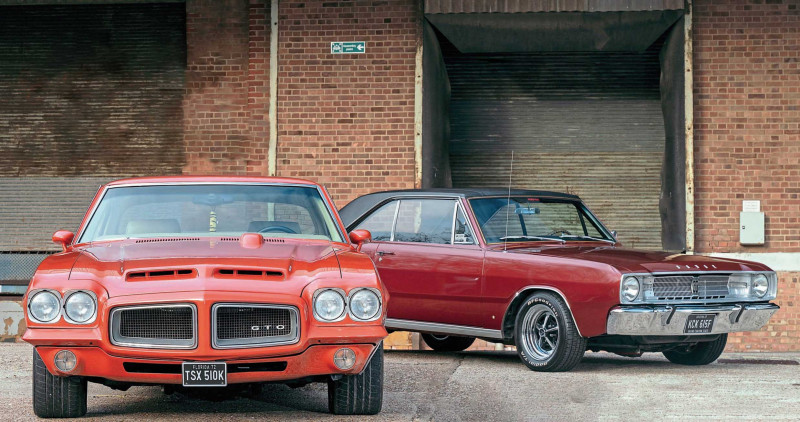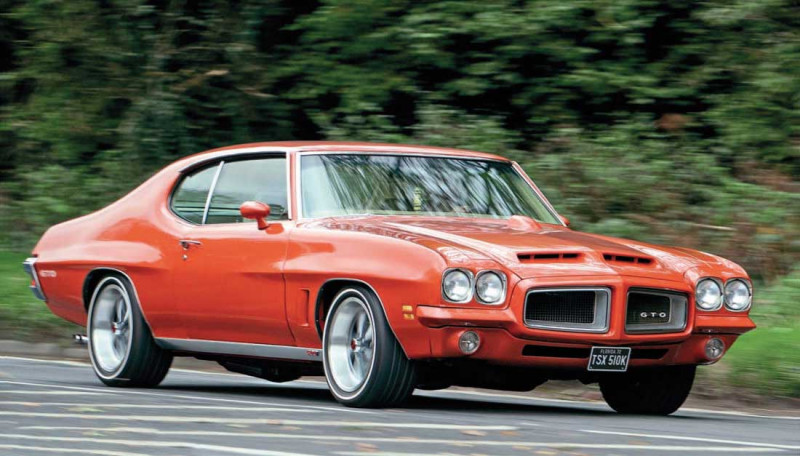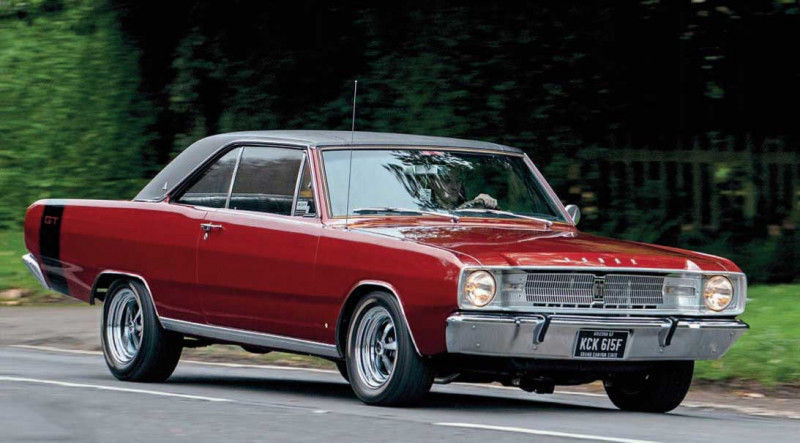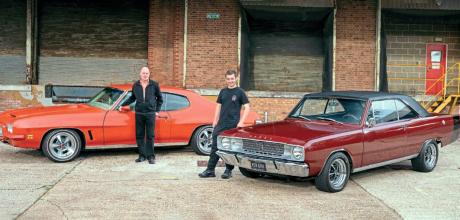1967 Dodge Dart GT and 1972 Pontiac Le Mans
When Jamie Webster bought himself a 1967 Dodge Dart, his father Howard decided Jamie couldn’t have all the fun, so he bought a 1972 Pontiac of his own…
Words: Mike Renaut
Photography: Matt Richardson
Like Father, Like Son
With his dad Howard being a dyed-in-the-wool hot rodder, it was inevitable that Jamie Webster would before long want some interesting cars of his own. Yet when he bought this 1967 Dodge Dart GT, it was Howard who then followed his son’s example and bought the other American car you see here, a 1972 Pontiac. “My dad has always been into hot rods and custom cars,” explains Jamie, “so that heavily influenced me, although the only modified cars I’d previously owned were a lowered Volkswagen Santana on AirRide suspension and an Audi estate. But we’ve been building a customised Ford 100E for a few years too. I was looking for an American car to drive to shows and use on weekends, but didn’t have a specific model in mind.

“IT ACTUALLY HANDLES REALLY WELL,” SAYS JAMIE, “THE SUPERSTOCK SPRINGS ACT AS ANTITRAMP BARS SO IT RIDES REALLY NICELY.”
“I knew I didn’t want a Mustang since there’s always one at even the smallest car show,” smiles Jamie, “but otherwise I was open to whatever came along. I spotted a Dodge Dart on eBay in the UK and really loved its shape. When I went to view it, that car wasn’t all that good close up and seemed expensive, so I got back on to eBay and found this 1967 Dart being sold at Gateway Classic Cars. It was the best example I could find and looked much like it is now, except it had Minilite wheels and a modern-style steering wheel. I then had Dean at Skippy’s Classic Imports (07583 665453/skippysclassicimports.co.uk) in Corby ship the Dart to the UK in summer 2019 and it turned out to be in much better condition than I’d expected.”

1972 Pontiac Le Mans
The previous owner of the Dodge, Andy Keyser of Oro Valley, Arizona, had first customised the Dart in 2007 and it appeared in Hemmings Muscle Machines that same year. “I tracked Andy down via Facebook and he was delighted the Dart had gone to a loving new home. He’d redone the Dart again in 2014 and then only driven it 5000 miles before selling it to build another car.”
According to the Hemmings article the Dart had previously been in Idaho and came to Andy with a bored ’69-vintage 340cu in V8.
Although on the same floorpan as previous Darts, the fourth-generation Dart’s bodywork looked all-new for 1967, boasting innovative curved side glass and thick rear roof pillars. Wagons were dropped from the range which comprised base Dart, 270 and GT models, with a GTS joining late in the year. Engines were a standard 170 or 225cu in slant-six or 273cu in V8, with optional 318, 340 and 383 cube V8s, and even Hemi cars in 1968. Although the front and rear of the Dart was facelifted annually, the centre section of the body remained the same until a new body arrived in 1976 and production of the fourth-generation Darts continued in South America until 1981.

1967 Dodge Dart GT
Jamie’s Dart was around the 5400th produced. One of about 21,600 eight-cylinder GTs built for the 1967 model year, it rolled out of Chrysler’s Los Angeles plant as a red GT with a 273cu in V8 and black vinyl top. It’s now a custom-mixed maroon called Cherry Dr Pepper, and that neat dart graphic on the bootlid was already hand-painted on the car when it arrived.
Keeping cool
Although Jamie was very happy with his purchase and the car was in great shape, he and Howard wanted to make some changes. “We put in a new four-core radiator to replace the three-core that was in there,” remembers Jamie, “added an uprated water pump and thermostat, then tidied the wiring which, although done safely enough, just looked messy. I also put on an aftermarket steering wheel that looks closer to the original and replaced the rear tail-light lenses. That’s one of the difficulties with certain years of cars; this being a 1967 Dart they were made in smaller numbers than the later cars so parts are harder to find – 1968 tail-lights are about £150, these 1967 ones are £400-500.”
Under the bonnet sits a 360cu in Dodge small-block V8, bored and stroked out to 408cu in. “Built by Arizona Race Company it has J-heads, a custom camshaft and forged internals, it’s around 495bhp, which is plenty in a small car. The transmission is a strengthened 904A TorqueFlite while the rear axle is an eight and three-quarter Sure Grip with 2:73 ratios.” The heater was removed, it obviously didn’t need one in Arizona, and the original hubs have been replaced for items with a more popular PCD to allow a better choice of aftermarket wheels to be fitted. “We put on a set of Magnum 500 wheels that were intended for a Mustang so we flattened out the domed centres on the lathe and Andy from Waterman Motorsports made new stickers for the centres in the style of the Mopar badges on the B-posts.”
Aftermarket disc brakes are fitted all round and you can’t fail to notice the rear sits a little higher than stock due to superstock-style rear springs with uprated leaves. “It actually handles really well,” says Jamie, “the superstock springs act as anti-tramp bars so it rides really nicely. I’ll probably fit a rear anti-roll bar in future.” Inside, the seats are the factory optional buckets in black vinyl; since the car apparently had 170,000 miles on it before Andy Keyser rebuilt it, they’ve obviously been retrimmed at some time. “I made a repair to a small tear, but otherwise it’s all in great shape.
“Driving it for the first time, it was a lot different from anything I’ve had before,” laughs Jamie. “It was a lot of firsts. The first American car I’d driven, first left-hand drive, first V8 and first rear-wheel drive; in fact, the first time I’d been behind the wheel of anything over 200bhp. But I’ve been careful and so far, it’s been great. Of course I respect the power, especially in the wet – it’ll spin the tyres at 50mph in spite of the Sure Grip. Those narrow rear tyres don’t help, but it’s too nice a body to cut out the arches or tub the rear. I’ve even been getting about 17mpg.
“I’ll be adding Bilstein shocks on the front as it’s a bit floppy and the race-style exhaust manifolds tend to scrape since they mount low to go under the control arms. Currently, it’s got exhaust pipes that end Hemi Dart-style part way along the floorpan and they sound muffled, so I’m going to extend them beyond the rear axle. I’m part of a club called Liberty and Lows (find them on Facebook) and all my Volkswagen mates say to lower it more, while the American car owners say it’s great just as it is. I’ve no plans to make any other changes to the Dart. To be honest, I almost sold it to buy a 1961 Cadillac recently, but now I’m glad I didn’t.”
Farewell gift
Having really enjoyed helping with son Jamie’s Dart, Howard was compelled to buy this 1972 Pontiac Le Mans. “I’m a mechanic and was into English Fords for a long time,” explains Howard. “Pops, Cortina GTs, Escorts, a Fiesta SuperSport − all of them hotted up – I built street and rally engines and I was hot-rodding another Ford Pop before we got the custom Ford 100E project we’re doing. But once the Dart arrived, I wanted an American car even more and, again, we were browsing websites when I saw the Pontiac at a dealership in Florida. Since I was retiring in 2022 I’d been looking for a Challenger or Barracuda, but prices were increasing almost weekly. I liked the paint colour on the Pontiac, loved the interior and from the description it sounded ideal, so that was my retirement present to myself and again we used Skippy’s to ship it over.
“I was pleasantly surprised when it arrived,” continues Howard, “and I went over it with a fine-tooth comb, even putting an endoscope up into all the cavities and I could not find any rust anywhere. There’s still factory undercoating under there and, wherever the line workers missed with that, is the original paint. The previous owner had bought it in California then taken it to New York in 2017 before moving to Florida, although the Le Mans was actually built in the Detroit, Michigan, factory.”
We keep referring to this Pontiac as a Le Mans, but you’ll have no doubt spotted that GTO badges adorn it front and rear. Howard continues: “I put those on. By the early 1970s muscle cars were getting expensive to insure, so a number of buyers went for the Le Mans model then ticked the boxes for all the GTO options. That way you could have the GTO experience but still insure the car as a Le Mans. This Le Mans left the factory essentially as a GTO just without the badges and it’s full of options.”
It certainly is. Options include power steering and power brakes, air conditioning, electric windows, heated rear screen, the Rallye Pack, Formula steering wheel, genuine functional Ram Air hood and manifold, Safe-T-Track limited slip differential, boxed suspension arms and the hood-mounted tachometer. “Since buying it, I’ve picked up all the Pontiac books and magazines I can find. Being a very early 1972 model, it apparently came with the 1971 interior too.
“For 1972 the boot spoiler became optional and that’s the only option it doesn’t have, otherwise it looks like a GTO.” A big part of that look is the T41 Endura front consisting of GTO fenders, hood scoops and impact-absorbing body-coloured ‘bumper.’ That was a $42 option for all other models, even base wagons, but could be deleted on the GTO in favour of chrome front bumper and grille.
Smaller muscles
In 1972, the GTO reverted from a separate model back to an optional trim package on the Le Mans (it had launched in 1964 as an option on the Tempest) and the Le Mans range comprised four different trim levels: GTO, Luxury, Sport and Base. Styling was facelifted again on a body which could be traced back to 1968. While Le Mans could be ordered as a hardtop (pillarless) coupe or pillared coupe, the Le Mans Sport came only as a hardtop, like Howard’s. A six-cylinder engine was standard in the Base while 350-, 400- or 455 cube V8s were options – happily, the 400cu in V8 and TH400 gearbox in this one are the original number matching parts – and 80,383 two-door hardtop Le Mans were built for the 1972 model year. Considering it has the 400 cube V8 and bucket seats, this Le Mans is almost certainly a Sport model.
The Pontiac is all about subtle upgrades, another example being the Rally II style wheels which are aftermarket rims measuring 9x17 inches rather than the original 7x15 and cover uprated four-wheel disc brakes. Howard’s Sundance Orange Pontiac also has a retrofitted VOE (Vacuum Operated Exhaust) option, briefly known as the ‘Humbler.’ Only fitted to 1970 models, and available for just a couple of months; a switch under the dashboard opens a cut-out in the exhaust to turn the pipe into a straight through system. “It sounds like a dragster then,” laughs Howard.
“It’s also lowered an inch and with the gas shocks and front/rear anti-roll bars, it rides better than my modern Mercedes. It had been dropped two inches at the rear, but that was too much so I put on new springs. I also replaced the hoses, but otherwise it’s not needed anything doing to it. When I first got the Pontiac I had to wait months for it to arrive since it was shipped right in the middle of the Covid-induced container crisis, then it took the DVLA ages to issue a number plate to me. Everyone was telling me American cars of this era don’t handle and wouldn’t go around corners, but it holds the road perfectly and it’s really comfortable. It just feels right. I’m going to add a finned deep aluminium gearbox sump to both our cars since that helps with cooling, but I’ve no plans to do anything else; just like Jamie’s Dart, this Pontiac is definitely a keeper.”
“EVERYONE WAS TELLING ME AMERICAN CARS OF THIS ERA DON’T HANDLE AND WOULDN’T GO AROUND CORNERS, BUT IT HOLDS THE ROAD PERFECTLY AND IT’S REALLY COMFORTABLE.”
Tilt steering wheel. TH400 auto ’box. Pontiac has been lowered by an inch and rides on adjustable gas-filled shocks. Howard added GTO stickers. Le Mans had spent time in California, New York and Florida. Power windows all round. Four-barrel 400cu in V8. Hood-mounted tach. 360cu in Dodge small-block V8 is bored and stroked out to 408cu in. Aftermarket steering wheel is a nice touch. Paint is a custom-mixed maroon called Cherry Dr Pepper. According to a previous article the Dodge hailed from Idaho originally. Simple black vinyl interior. In all, about 21,600 V8 GTs were built in ’67.


